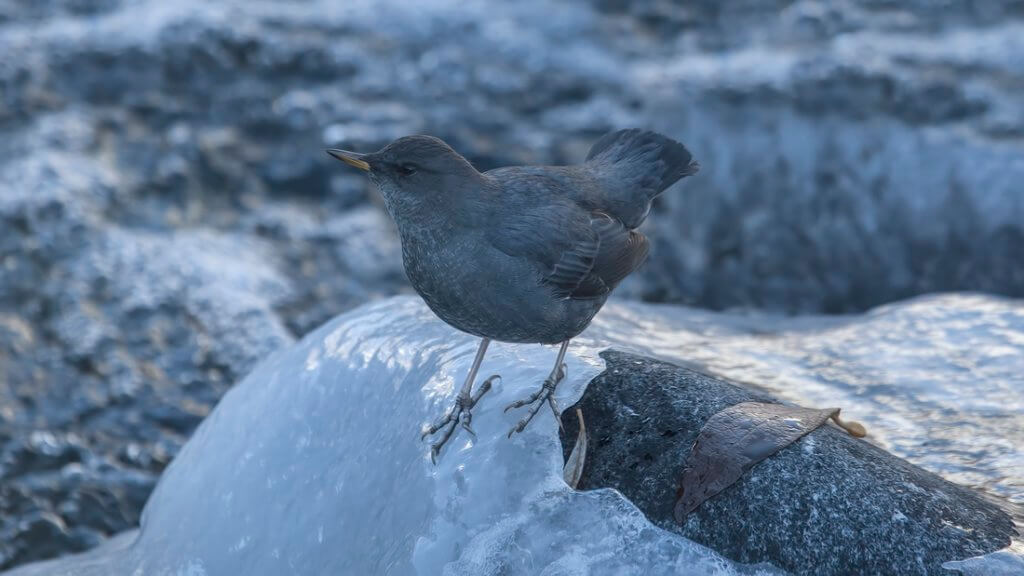American Dippers: Singing From Montana’s Icy Streams
by Deborah Richie
Broadcast 9.1993, 12.2002, 1.2008, 1.2015

American Dipper in winter. Photo by Alan D. Wilson, naturespicsonline.com.
Listen:
Skiing next to Rattlesnake Creek on a morning so cold that ice crystals dance in the air, the world seems silent, asleep. Then, a brilliant melody pours forth like a breath of spring. The sound seems to come from the water itself. I ski closer to the ice-lined creek and a splash in the shallows reveals a plump little stub-tailed bird whose dark coloring blends perfectly with the drab grey rocks.
This is a dipper, or water ouzel – a year-round native of Montana’s rushing, forested streams. Not only does the dipper brave the harsh winters, but this water-loving bird dares to sing on the coldest of days. In fact, February marks the start of courtship for dippers.
In the late 1800’s, conservationist and writer John Muir wrote enthusiastically about this denizen of waterfalls and rapids:
As for the weather, dark days and sun days are the same to him. Indeed no storm can be more violent than those of the waterfalls in the midst of which he delights to dwell. However dark and boisterous the weather, snowing, blowing or cloudy, all the same he sings, and with never a note of sadness.
What is so special about the dipper that allows this inconspicuous bird to plunge off the ice into freezing water and move beneath the surface in search of aquatic insects?
When a dipper emerges from the water, its feathers appear mysteriously dry. That’s because dippers waterproof their feathers with oil created by a preen gland that is 10 times the size of any other songbird’s. Feather preening is an important part of a dipper’s day. Beneath the 6,000 or so well-oiled feathers lies a layer of soft down.
And that’s not all. When you watch a dipper closely, you may see a milky white membrane flash across its eye when it blinks. This is a special device called a nictitating membrane. It’s actually a third eyelid that works like goggles to protect dippers from the spray of waterfalls. A scaly flap folds over the dipper’s nostrils to keep water out during its underwater forays.
Look for dippers bobbing up and down as if performing an athletic series of deep knee bends. No one knows why dippers dip, but this action is their trademark, especially when people, predators, or other dippers approach. In winter, frozen-over streams will force dippers to lower elevations. Greenough Park in downtown Missoula offers excellent winter dipper viewing.
Watching dippers and listening to their buoyant song ought to be prescribed as a sure cure for the winter blues.
Every week since 1991, Field Notes has inquired about Montana’s natural history. Field Notes are written by naturalists, students, and listeners about the puzzle-tree bark, eagle talons, woolly aphids, and giant puffballs of Western, Central and Southwestern Montana and aired weekly on Montana Public Radio.
Click here to read and listen to more Field Notes. Field Notes is available as a podcast! Subscribe on iTunes, Google Play, or wherever you listen to podcasts.
Interested in writing a Field Note? Contact Allison De Jong, Field Notes editor, at adejong [at] montananaturalist [dot] org or 406.327.0405.
Want to learn more about our programs as well as fun natural history facts and seasonal phenology? Sign up for our e-newsletter! You can also become a member and get discounts on our programs as well as free reciprocal admission to 300+ science centers in North America!












